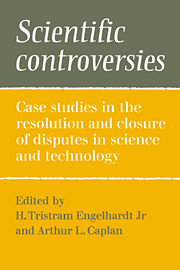 Scientific Controversies
Scientific Controversies Book contents
- Frontmatter
- Contents
- Preface
- List of contributors
- Introduction: Patterns of controversy and closure: the interplay of knowledge, values, and political forces
- PART I THEORETICAL PERSPECTIVES
- PART II CONTEMPORARY CASE STUDIES
- 12 Resolution of the Laetrile controversy: past attempts and future prospects
- 13 Federal regulation of Laetrile
- 14 Quasi libertarianism and the Laetrile controversy
- 15 Judicial deflection of scientific questions: pushing the Laetrile controversy toward medical closure
- 16 Politics, science, and the problem of psychiatric nomenclature: a case study of the American Psychiatric Association referendum on homosexuality
- 17 The diagnostic status of homosexuality in DSM-III: a reformulation of the issues
- 18 On arriving at the American Psychiatric Association decision on homosexuality
- 19 Values in the debate over workplace safety and health: the rancorous rhetoric about regulation
- 20 The successful experiment that failed
- 21 The power of efficiency: balancing benefits and costs in regulating occupational exposure to toxic substances
- 22 Closure in occupational safety and health: the benzene and cotton dust decisions
- 23 Nuclear fear: a history and an experiment
- 24 Closure and controversy: Three Mile Island
- 25 Understanding the nuclear power controversy
- PART III CONTROVERSY, CLOSURE, AND THE PUBLIC
- Author index
- Subject index
21 - The power of efficiency: balancing benefits and costs in regulating occupational exposure to toxic substances
Published online by Cambridge University Press: 03 February 2010
- Frontmatter
- Contents
- Preface
- List of contributors
- Introduction: Patterns of controversy and closure: the interplay of knowledge, values, and political forces
- PART I THEORETICAL PERSPECTIVES
- PART II CONTEMPORARY CASE STUDIES
- 12 Resolution of the Laetrile controversy: past attempts and future prospects
- 13 Federal regulation of Laetrile
- 14 Quasi libertarianism and the Laetrile controversy
- 15 Judicial deflection of scientific questions: pushing the Laetrile controversy toward medical closure
- 16 Politics, science, and the problem of psychiatric nomenclature: a case study of the American Psychiatric Association referendum on homosexuality
- 17 The diagnostic status of homosexuality in DSM-III: a reformulation of the issues
- 18 On arriving at the American Psychiatric Association decision on homosexuality
- 19 Values in the debate over workplace safety and health: the rancorous rhetoric about regulation
- 20 The successful experiment that failed
- 21 The power of efficiency: balancing benefits and costs in regulating occupational exposure to toxic substances
- 22 Closure in occupational safety and health: the benzene and cotton dust decisions
- 23 Nuclear fear: a history and an experiment
- 24 Closure and controversy: Three Mile Island
- 25 Understanding the nuclear power controversy
- PART III CONTROVERSY, CLOSURE, AND THE PUBLIC
- Author index
- Subject index
Summary
The costs imposed by federal regulatory activities serve as banner and litmus test for those seeking to curtail government involvement in the economy. Interest in deregulation encompasses both economic and environmental/public health regulation, although the purposes of each are quite different, as are the criteria appropriate to their assessment. The focus on costs has stimulated an effort to demonstrate the magnitude of benefits provided through regulation. This effort encounters serious methodological difficulties in the environmental/ public health area, including the imputation of economic value to human life, and poorly defined health outcomes.
The Occupational Safety and Health Administration (OSHA) has resisted pressures to quantify the benefits expected from more stringent standards for occupational exposures, but recent and imminent Supreme Court decisions or congressional action may compel the agency to incorporate procedures for weighing benefits and costs to justify exposure standards.
This essay is an examination of some of the pros and cons of this possible development in OSHA's regulatory process. In particular, it argues that benefit–cost methodology is insufficiently developed for handling major elements of regulatory decisions in this area; that its use can only extend the range of controversy, and that the focus of the benefit–cost/efficiency paradigm ignores important aspects of social structure, discouraging efforts to enhance the health resource base of particular groups and neglecting the consequences of the form in which certain costs are imposed.
The past decade has been marked by legislation aimed at controlling human exposure to toxic substances. This legislation includes numerous acts that address various substances in diverse exposure settings.
- Type
- Chapter
- Information
- Scientific ControversiesCase Studies in the Resolution and Closure of Disputes in Science and Technology, pp. 487 - 504Publisher: Cambridge University PressPrint publication year: 1987


